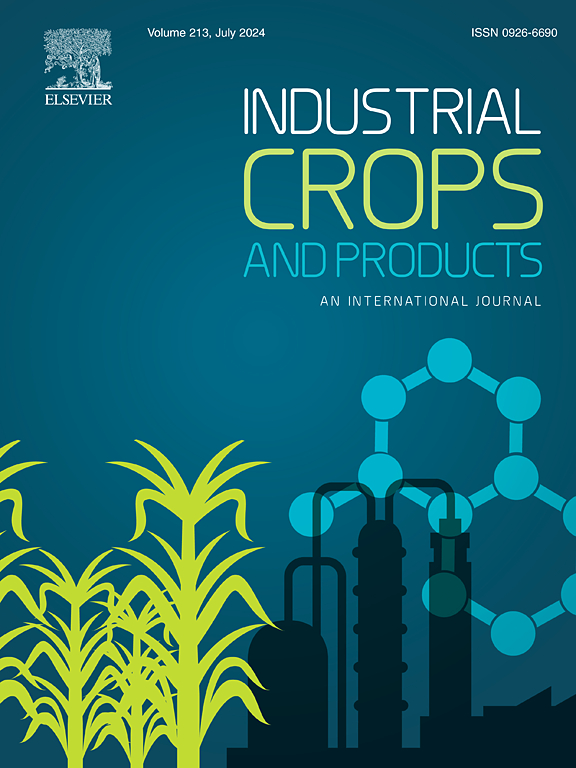Exploring the value of Dioscorea melanophyma: an orphan crop from China
IF 5.6
1区 农林科学
Q1 AGRICULTURAL ENGINEERING
引用次数: 0
Abstract
Dioscorea melanophyma is a wild relative of cultivated yam, and its development and utilization are strategically important for food security. This study aims to investigate the germplasm resources, ethnobotany, pests, and diseases of D. melanophyma, and to examine the impact of climate change on its distribution and survival. The study also assesses the nutritional value of the tubers and bulbils, and investigates the pattern of bulbil germination and associated changes in endogenous hormone levels. The survey finds that D. melanophyma is mainly distributed in southwest China, and its tubers and bulbils are recorded as edible. The major diseases of this species are white rust and anthracnose, and the pests are the species Lilioceris sinica, and the families of Arctiidae, Agromyzidae, and Elateridae. Temperature annual range (Bio7), elevation and min temperature of coldest month (Bio6) were found to significantly influence the distribution of D. melanophyma, with cumulative contribution and ranked importance of the MaxEnt model reaching 87.3 % and 89.5 %, respectively. In the future, the area of highly suitable habitats for D. melanophyma will decrease dramatically, while moderately and lowly suitable are will increase. The tubers and bulbils of D. melanophyma are rich in nutrients and have a higher nutritional value score than those of D. polystachya. Dioscorea melanophyma reproduces asexually, primarily through the numerous bulbils it produces. Early in the year (before March), high concentrations of abscisic acid in the bulbils inhibit germination through physiological dormancy. From April on, many bulbils begin to germinate, achieving a germination rate of 90 % within one month. In conclusion, D. melanophyma exhibits significant developmental potential, and is likely to serve as a crucial genetic resource for yam cultivation and play a vital role in food security. This comprehensive study on D. melanophyma aims to offer valuable information and insights to consumers, producers, and researchers alike.
中国孤儿作物黑桫椤的价值探讨
黑瘤薯蓣(Dioscorea melanophyma)是栽培山药的野生亲缘植物,其开发利用对粮食安全具有重要的战略意义。本研究旨在调查黑霉的种质资源、民族植物学、病虫害,并探讨气候变化对其分布和生存的影响。该研究还评估了块茎和球茎的营养价值,并研究了球茎萌发模式和内源激素水平的相关变化。调查发现,黑藻主要分布在中国西南地区,其块茎和球茎均有可食记录。主要病害为白锈病和炭疽病,害虫为黄花百合科、针叶虫科、稻蝇科。气温年差(Bio7)、海拔高度和最冷月最低温度(Bio6)显著影响黑藻的分布,MaxEnt模型的累积贡献率和排名重要性分别达到87.3 %和89.5 %。未来,黑桫椤高度适宜生境面积将急剧减少,而中、低适宜生境面积将增加。黑藻的块茎和球茎营养成分丰富,营养价值评分高于多穗草。黑瘤薯蓣无性繁殖,主要通过它产生的大量鳞茎进行繁殖。年初(3月前),球茎中高浓度的脱落酸通过生理休眠抑制发芽。从4月开始,许多球茎开始发芽,在一个月内达到90% %的发芽率。综上所述,黑藻菌具有显著的发育潜力,有可能成为山药栽培的重要遗传资源,并在粮食安全中发挥重要作用。这项全面的研究旨在为消费者、生产者和研究人员提供有价值的信息和见解。
本文章由计算机程序翻译,如有差异,请以英文原文为准。
求助全文
约1分钟内获得全文
求助全文
来源期刊

Industrial Crops and Products
农林科学-农业工程
CiteScore
9.50
自引率
8.50%
发文量
1518
审稿时长
43 days
期刊介绍:
Industrial Crops and Products is an International Journal publishing academic and industrial research on industrial (defined as non-food/non-feed) crops and products. Papers concern both crop-oriented and bio-based materials from crops-oriented research, and should be of interest to an international audience, hypothesis driven, and where comparisons are made statistics performed.
 求助内容:
求助内容: 应助结果提醒方式:
应助结果提醒方式:


